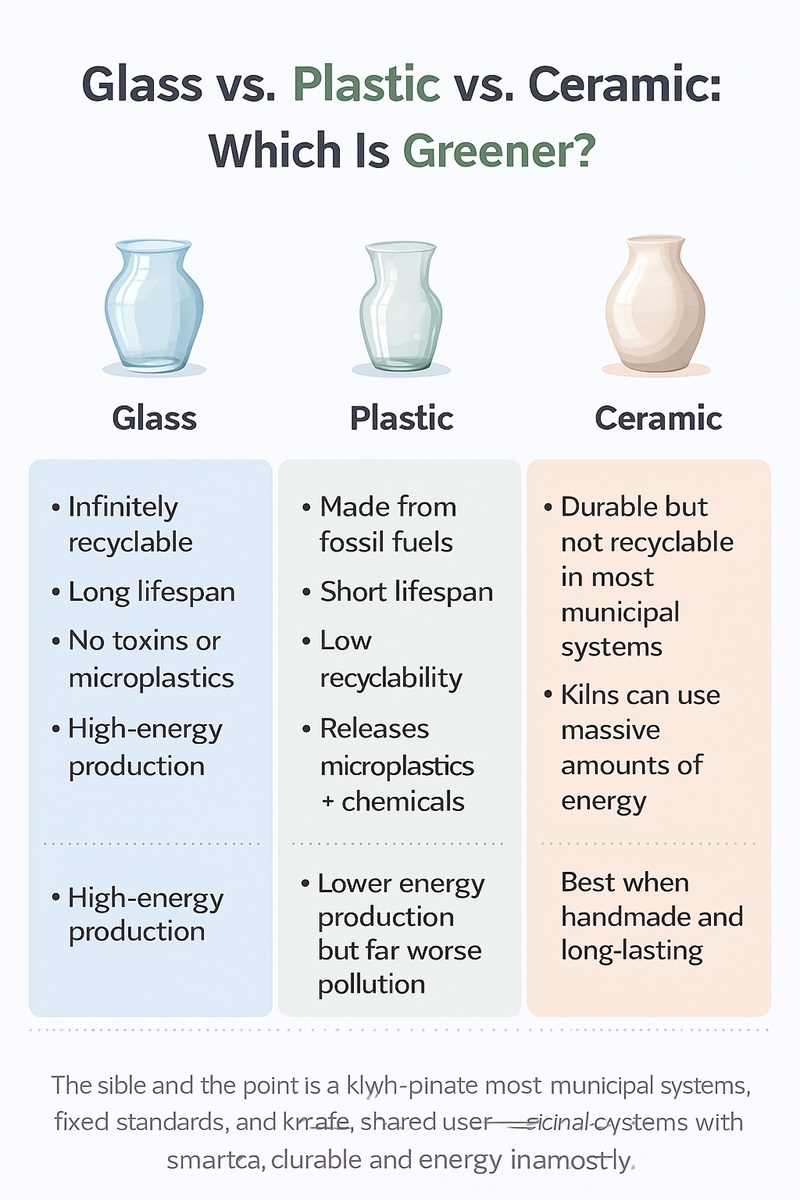When you think about eco-friendly decor, you may picture wood, bamboo, or linen. Glass vases might not be the first thing you consider. They seem simple and common, so many people don’t think of them as “green.” But glass vases can be a very eco-friendly choice when used the right way.
This guide explains how sustainable glass vases really are, how to choose the best ones, and why they can fit well in a low-waste home.
What Makes a Material Eco-Friendly?
Before we decide if glass is good for the planet, it helps to know what makes any material eco-friendly. A sustainable material is one that has a low impact on the environment from start to finish. Key things to look at include:
- Renewable Resources: Does it come from a source that can be replaced?
- Recyclability: Can we recycle it easily?
- Energy in Production: How much energy does it take to make it?
- Longevity: How long will it last?
- End of Life: Can it be reused or repurposed when we no longer need it?
Now let’s see how glass compares.
The Lifespan of Glass Vases: Made to Last
One of the best things about glass is its long life. A well-made glass vase can last for decades. If you take care of it, it may even stay in your family for generations.
Glass does not break down into harmful microplastics. It also doesn’t release toxins the way some plastics can. This means you won’t need to replace it often, which cuts down on waste. A long-lasting item is almost always better for the planet.
Recyclability: Where Glass Truly Shines
One of glass’s biggest environmental advantages is its recyclability. Unlike many materials that weaken with each cycle, glass can be recycled endlessly without losing quality. This makes it a “closed-loop” material—rare in consumer goods.
A few key facts strengthen its eco case:
- Recycling glass can cut manufacturing energy use by up to 30% compared to using raw sand.
- Every ton of recycled glass saves roughly 580 kg of CO₂ emissions on average.
- Many modern vases are already made with 30–100% recycled cullet (crushed recycled glass).
When shopping, look for labels like:
- “Made from 100% recycled glass”
- “Post-consumer cullet”
- “EcoGlass” or Cradle to Cradle–certified products
Recycling does vary by region, but clear and green glass are widely accepted in most systems.
The Drawback: Glass Production Requires High Energy
For all its strengths, glass does have one clear downside—it takes a lot of heat to make. Sand, soda ash, and limestone must be melted at temperatures around 2,500°F (1,370°C), typically using fossil fuels.
This is the single biggest environmental footprint associated with glass.
But the industry is shifting:
- Some manufacturers now run electric or hybrid furnaces powered by renewable energy.
- Others use advanced refractory materials that reduce heat loss.
- Brands with sustainability programs often use a higher percentage of cullet, lowering both emissions and energy use.
If you want a greener choice, prioritize:
- recycled glass
- handmade or small-batch artisan vases
companies that disclose sustainable production practices
The good news is that many companies are now shifting toward cleaner methods. Some brands are using renewable energy, better furnaces, and more efficient systems. If you want a greener option, look for labels like “eco-friendly,” “recycled,” or “sustainably made.”
Jamali Garden is one brand known for offering stylish glass vases while keeping sustainability in mind.

Glass vs. Plastic: Which Is Better?
If you’re choosing between glass and plastic, glass is almost always the greener option. Plastic is made from petroleum, a non-renewable resource. It may be cheap and light, but it has a huge environmental cost.
Plastic vases often end up in landfills, where they can take hundreds of years to break down. They may also leak harmful chemicals into soil and water. Glass vases last much longer, can be reused in many ways, and can be recycled forever.
Does the Design Matter?
Yes, design matters when choosing a sustainable glass vase. Simple designs are usually better. Heavy paint, coatings, or special finishes can make the vase harder to recycle.
Try to choose clear or plain glass. These are accepted more often at recycling centers. Minimalist designs also last longer because they stay in style.
Can You Upcycle Glass?
Absolutely. Glass is one of the easiest materials to upcycle. If your vase chips, cracks, or no longer fits your style, you can turn it into something new. Many people use old glass vases as:
- candle holders
- plant pots
- desk organizers
- garden décor
Upcycling gives the vase a new life and keeps it out of the landfill.
How to Choose Better Glass Vases
If you want a greener home, a few small choices make a big difference:
- Choose recycled glass. Many brands now highlight when their products use recycled materials.
- Pick one versatile vase. A single, multi-use vase can work for flowers, plants, or storage.
- Buy local or handmade. Artisan-made glass usually comes from smaller workshops that often use better practices. You also cut the emissions from shipping.
- Care for your vases. Clean gently and avoid harsh chemicals to help your vase last for many years.
Final Thoughts
So, are glass vases eco-friendly? Yes—when made well and used mindfully. They last a long time, can be recycled endlessly, and avoid the pollution problems tied to plastic. Choosing recycled glass, supporting sustainable brands, and reusing or upcycling what you already have all help reduce waste.
Small choices in home décor can make a big difference. A simple glass vase can be a stylish, durable, and planet-friendly piece that fits beautifully into a greener home.




